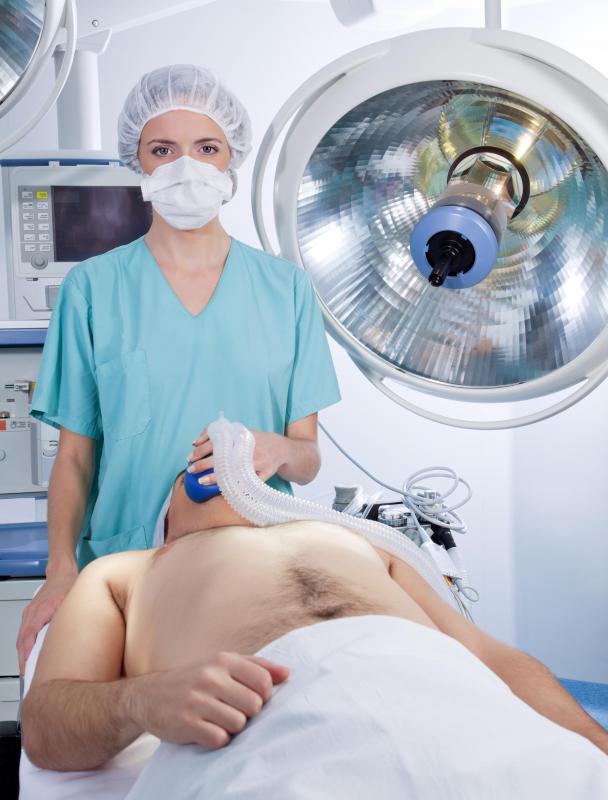At WiseGEEK, we're committed to delivering accurate, trustworthy information. Our expert-authored content is rigorously fact-checked and sourced from credible authorities. Discover how we uphold the highest standards in providing you with reliable knowledge.
What is Laminoplasty?
Laminoplasty is a procedure performed to increase the width of the spinal canal for the purpose of relieving pressure on the spinal cord. It is most commonly done to treat spinal stenosis, a condition characterized by narrowing of the spinal canal. Laminoplasties are performed by experienced spinal surgeons on patients who are fully anesthetized. The procedure usually takes around two hours, although sometimes complications cause the surgery to run longer.
In a laminoplasty, the surgeon turns an area of the vertebra known as the lamina into what is essentially a little door. This is done by cutting one side of the lamina away from the vertebra, and either scoring the other side or cutting it away as well. This creates a flap of bone which can be hinged outward to make more room in the spinal canal. Metal clips are used to hold the door open, leaving the spinal canal permanently widened while keeping protection of the spinal cord intact by leaving the lamina intact. Typically, several vertebrae are treated in this way during a laminoplasty.

An alternative to this procedure is a laminectomy, in which the lamina of the bone is taken out entirely. Preference for one surgery or the other is usually based on the surgeon's experience and the specifics of the case. A surgeon may review both options with the patient if they can both be considered viable choices so that the patient has an opportunity to choose which procedure she or he would like to undergo.

There are risks to a laminoplasty, as with any surgical procedure. Being under general anesthesia creates a number of risks of complications which can occur on the operating table, and after anesthesia, the patient is at risk of lung problems. Patients are also at risk of infection and nerve damage which can occur even after the most carefully performed surgery. People can decrease their risk of complications by working with a highly experienced surgeon in a reputable surgical facility.

Before undergoing laminoplasty, a patient should talk with the surgeon about why the procedure is being performed, what will happen during the surgery, and what to expect after surgery. It is advisable to go over recovery and aftercare before surgery so that the patient can prepare. Being aware of aftercare needs can also be important for friends and family members who may help the patient during laminoplasty recovery, as well as employers who need to make accommodations for employees recovering from surgery.
AS FEATURED ON:
AS FEATURED ON:

















Discussion Comments
Unfortunately, this is one of the many diseases that can affect you as you get older. People never really evolved to live as long as we are able to now, and the pressures we put on our bodies have to show up sometime.
Apparently this kind of stenosis can show up because of trauma or infection as well.
Luckily, if it's only a two hour procedure it can't be all that complicated, but I hate the idea of getting part of my spine cut out. I hope that I never have to have this kind of cervical surgery, but odds are, I'm going to have to have something done before I get past old age.
@pleonasm - That's very sad about your dog. Unfortunately, there are several breeds of dog which are prone to getting spinal stenosis as they grow older, and very few people can afford to get a laminoplasty for a dog. It's a difficult procedure, even for a human surgeon, just because any time you are operating on the spine, there is a risk of nerve damage which could aggravate the symptoms of the stenosis, rather than relieve them.
Imagine, on a dog the spine would be that much smaller and more difficult to work with.
This is one of the reasons it's a good idea to insure your pets though. Just in case something like this happens.
My dog had this condition when I was a teenager. It was really sad because he was such a brave dog, he never showed that he was in discomfort, even though he must have been in quite a lot of pain.
Unfortunately, because he didn't show he was in pain, we didn't realize what was wrong until he started having trouble urinating, which is apparently a difficult with people who have spinal stenosis as well.
By that point the vet basically told us that he wasn't likely to survive the surgery and that it was going to cost thousands of dollars that my parents couldn't afford. He said our only other option was to try and regularly press on our dog's stomach to help him empty his bladder, but he said it was a very difficult thing to do and it wouldn't really help with the pain.
So, we had to have him put down. It was one of the saddest days of my life. Thank goodness people can articulate what is wrong, and get it fixed before it gets too bad.
Post your comments